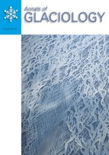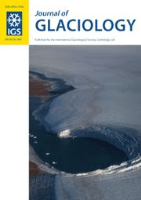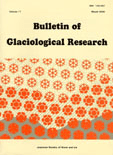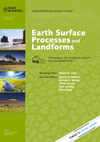
ANNALS OF GLACIOLOGY
Scope & Guideline
Illuminating the Dynamics of Ice and Climate
Introduction
Aims and Scopes
- Cryospheric Dynamics and Processes:
Research on the physical and dynamic processes governing glaciers and ice sheets, including flow dynamics, mass balance, and the impact of climate change. - Remote Sensing and Geospatial Analysis:
Utilization of satellite and aerial imagery, along with ground-based measurements, to monitor and analyze changes in ice and snow cover, including the development of new algorithms and models. - Subglacial and Ice-Shelf Processes:
Investigating subglacial hydrology, ice-shelf stability, and interactions between ice and underlying geology, which are crucial for understanding ice dynamics and melt rates. - Glacial Geomorphology and Sedimentology:
Study of landforms and sediment processes associated with glaciers, including geomorphological mapping and analyses of sediment transport and deposition. - Impact of Glaciers on Ecosystems and Society:
Exploration of how changes in glacier systems affect water resources, ecosystems, and human activities, emphasizing the societal implications of glacial retreat and changes in ice mass.
Trending and Emerging
- Climate Change Impact on Glaciers:
Research focusing on the effects of climate change on glacier dynamics, melting processes, and mass balance is increasingly prevalent, highlighting the urgency of understanding these changes. - Advanced Modeling Techniques:
There is a growing trend towards using sophisticated modeling techniques, including machine learning and multi-dimensional simulations, to predict glacial behavior and responses to environmental changes. - Subglacial Hydrology Research:
Increased attention is being paid to the role of subglacial hydrology in ice dynamics, with studies exploring how meltwater influences ice flow and stability. - Community Engagement and Socio-Ecological Impacts:
Emerging research themes are focusing on the socio-ecological impacts of glacier changes, emphasizing the importance of community engagement and policy implications. - Technological Innovations in Glaciology:
The integration of new technologies, such as UAVs and advanced remote sensing tools, is trending, enabling more precise and comprehensive glaciological studies.
Declining or Waning
- Historical and Cultural Aspects of Glaciology:
Research exploring the historical and cultural implications of glaciers has decreased, possibly as the field shifts towards more empirical and data-driven studies. - Glacial Archaeology and Ancient Human Interactions:
The exploration of ancient human interactions with glacial environments has waned, with fewer studies published on archaeological findings in glacial contexts. - Traditional Remote Sensing Techniques:
Focus on conventional remote sensing techniques has diminished as the field embraces more advanced methods such as machine learning and enhanced radar technologies. - Microstructural Ice Studies:
While still relevant, the specificity of microstructural studies of ice has seen a reduction in frequency, possibly overshadowed by broader studies on ice dynamics and mass balance.
Similar Journals

Cuaternario y Geomorfologia
Fostering Knowledge in Quaternary ResearchCuaternario y Geomorfologia is a distinguished journal published by the Spanish Quaternary Research Association, focusing on the interdisciplinary study of Quaternary research, geomorphology, and related fields. With its ISSN 0214-1744 and a publication history spanning from 2012 to 2024, the journal serves as a critical platform for researchers and practitioners in geography, geology, and paleontology. Although its current Scopus rankings place it in the lower quartiles across various categories, being Q4 in Earth-Surface Processes, Geography, Planning and Development, Geology, and Paleontology, Cuaternario y Geomorfologia continues to push boundaries within its sphere, aiming to foster a deeper understanding of Earth sciences. Situated in Madrid, Spain, the journal's commitment to sharing groundbreaking research without access barriers enhances its value for academics, offering insights that drive forward the fields of Quaternary studies and beyond. Researchers, professionals, and students alike will find a rich repository of knowledge within its pages, making it an essential resource for current and aspiring experts in the discipline.

Quaternary Science Advances
Unlocking the Secrets of Quaternary EnvironmentsQuaternary Science Advances, published by ELSEVIER, is a distinguished open access journal that has rapidly gained recognition in the fields of Earth and Planetary Sciences since its inception in 2020. With an impressive impact factor reflected by its Q2 ranking across various categories including Earth-Surface Processes and Geology, this journal serves as a vital platform for researchers and professionals aiming to advance the understanding of Quaternary environments and processes. Positioned within the 73rd percentile in Earth and Planetary Sciences and bolstered by a robust global readership, Quaternary Science Advances not only facilitates the dissemination of high-quality research but also encourages interdisciplinary collaboration. The journal’s open access model ensures that cutting-edge findings are readily available to students, researchers, and practitioners across the globe. With a commitment to promoting innovative studies from 2020 to 2024 and beyond, this journal remains a cornerstone for advancing knowledge within the dynamic landscape of Earth sciences.

Frontiers of Earth Science
Unveiling the Secrets of Earth ScienceFrontiers of Earth Science is a prominent academic journal in the field of Earth and Planetary Sciences, published by Springer. With an ISSN of 2095-0195 and an E-ISSN of 2095-0209, this journal serves as a significant platform for researchers and professionals to disseminate their findings from 2007 to 2024. It is recognized for its impactful contributions within the category of Earth and Planetary Sciences, boasting a respected Q2 ranking in 2023. With a Scopus ranking of 64 out of 195, placing it in the 67th percentile, Frontiers of Earth Science continues to drive academic dialogue and innovation. The journal is dedicated to exploring a diverse range of topics, including geology, meteorology, and environmental science, and amplifying the understanding of Earth systems through rigorous research. Located in New York, USA, this journal embraces an Open Access model, ensuring that groundbreaking research is readily available to the global scientific community, thereby enhancing its accessibility and impact.

Water Practice and Technology
Shaping the Future of Water through Open Access ResearchWater Practice and Technology is a distinguished open-access journal published by IWA PUBLISHING, dedicated to disseminating cutting-edge research and practical insights within the field of water science and technology. With an E-ISSN of 1751-231X, the journal has been at the forefront of sharing knowledge since its inception in 2011 and has transitioned to open access in 2021, providing unrestricted access to high-quality research articles. Based in the United Kingdom, this journal plays a vital role in advancing the understanding of water resource management, treatment technologies, and environmental sustainability. As of 2023, it is categorized in the Q3 quartile for Water Science and Technology with a Scopus rank of #157/261, placing it in the 40th percentile among its peers. Researchers, professionals, and students alike will find the journal a valuable resource for the latest trends, innovations, and practical applications in the water sector, facilitating a collaborative approach towards addressing global water challenges.

Journal of Mountain Science
Advancing Insights into Earth's Majestic Mountain EnvironmentsThe Journal of Mountain Science, published by SCIENCE PRESS, is a distinguished academic journal dedicated to advancing the understanding of mountain environments and their significance in various scientific domains. With an ISSN of 1672-6316 and an E-ISSN of 1993-0321, this journal has carved a niche in the field of Earth sciences, earning a commendable Q2 ranking in categories such as Earth-Surface Processes, Geography, Planning and Development, and Geology, as well as a Q3 ranking in Global and Planetary Change. Since its inception in 2007, the journal has been pivotal in fostering interdisciplinary research that addresses critical environmental issues, making it an essential resource for researchers, professionals, and students alike. While currently not offering open access, it provides valuable insights into areas including nature conservation and landscape management, with a focus on the unique challenges faced by mountainous regions. Located in Beijing, China, the Journal of Mountain Science continues to promote scholarly discourse that contributes to the sustainable development of mountain communities and ecosystems until 2024 and beyond.

JOURNAL OF GLACIOLOGY
Illuminating the science behind glacial change and environmental impact.JOURNAL OF GLACIOLOGY, published by Cambridge University Press, is a leading open-access journal dedicated to advancing the scientific study of glaciers and ice sheets, with a particular focus on their interactions within Earth’s systems. With an ISSN of 0022-1430 and E-ISSN of 1727-5652, this journal has established itself as an influential platform since its inception, currently ranked in the Q1 category of Earth-Surface Processes in 2023. The journal is based in the United Kingdom and has witnessed a convergence of pivotal research from various periods spanning from 1977 through to 2024. It enjoys a commendable Scopus rank of #29 out of 179 in Earth and Planetary Sciences, affirming its impact with an impressive 84th percentile. The open-access model adopted since 2016 enhances its accessibility, enabling a wider audience of researchers, students, and professionals to engage with high-quality research on glaciology, climate change, and environmental systems. By fostering interdisciplinary dialogue and disseminating innovative findings, the JOURNAL OF GLACIOLOGY plays a crucial role in enhancing our understanding of glacial dynamics and their significance in our rapidly changing world.

Revista Brasileira de Geomorfologia
Unveiling the Processes Shaping Our PlanetRevista Brasileira de Geomorfologia is a prominent open-access journal dedicated to the field of geomorphology, fostered by the UNIAO GEOMORFOLOGIA BRASILEIRA since its inception in 2000. Based in Brazil, this journal serves as a vital platform for researchers, professionals, and students to disseminate and engage with cutting-edge research on the dynamic processes shaping the Earth's surface. With an ISSN of 1519-1540 and an E-ISSN of 2236-5664, it has earned its place within the academic community, ranking in the Q3 category in the Earth-Surface Processes domain according to the latest 2023 quartiles. The journal's metrics, including a Scopus rank of 123/179 within its category, reflect its commitment to quality research. By facilitating open access to its content, the Revista Brasileira de Geomorfologia not only promotes scholarly communication but also enhances the visibility of vital studies detrimental to understanding geomorphological transformations and environmental change. Join the ongoing discourse and contribute to advancing knowledge in this essential field of Earth sciences.

Bulletin of Glaciological Research
Exploring the icy frontiers of Earth’s surface processes.Bulletin of Glaciological Research is a distinguished journal dedicated to advancing the field of Earth surface processes and glaciology, proudly published by the NIHON SEPPYO GAKKAI-JAPANESE SOC SNOW & ICE. With an ISSN of 1345-3807 and an E-ISSN of 1884-8044, this journal serves as a vital platform for researchers and professionals interested in snowy and icy environments, particularly within the context of the dynamic changes occurring in these regions. The journal has achieved a commendable ranking in the Scopus Earth and Planetary Sciences category, ranking #90 out of 179 and sitting within the 50th percentile, reflecting its importance and impact in the scientific community. Encompassing research from 2009 to 2024, it aims to disseminate innovative findings, foster collaboration, and promote awareness of glaciological issues. While not an open access journal, its contributions are invaluable for students, academics, and industry professionals looking to stay abreast of the latest developments in this critical field.

EARTH SURFACE PROCESSES AND LANDFORMS
Exploring the Forces that Shape Our PlanetEARTH SURFACE PROCESSES AND LANDFORMS is a renowned academic journal dedicated to the comprehensive exploration of dynamic processes shaping the Earth's surface. Published by Wiley, this esteemed journal has established itself as a leading platform in the fields of Earth and Planetary Sciences, Geography, Planning, and Development. With an impressive Impact Factor and ranked in the Q1 category for multiple disciplines, it consistently features cutting-edge research that contributes to the understanding of geomorphology, hydrology, and related environmental phenomena. Researchers and professionals can benefit from the journal's extensive repository of high-quality studies, making it a crucial resource for advancing knowledge in these vital areas. As it continues to converge from 1981 to 2024, EARTH SURFACE PROCESSES AND LANDFORMS remains pivotal for scholars aiming to engage in high-level discourse and discovery in Earth sciences.

DOKLADY EARTH SCIENCES
Bridging Gaps in Earth Science UnderstandingDOKLADY EARTH SCIENCES is a reputable journal published by MAIK NAUKA/INTERPERIODICA/SPRINGER, focusing on the dynamic field of Earth and Planetary Sciences. With an ISSN of 1028-334X and E-ISSN 1531-8354, this journal offers a platform for researchers to disseminate their findings and insights that contribute to our understanding of Earth systems over a continuous publishing span from 1998 to 2024. It currently holds a Q3 quartile ranking in the Earth and Planetary Sciences category, reflecting an emerging yet significant impact within its field, evidenced by its Scopus ranks where it stands at 123rd in general Earth sciences and 113th in miscellaneous Earth sciences. DOKLADY EARTH SCIENCES aims to bridge research gaps and foster collaboration among a diverse audience including researchers, professionals, and students committed to advancing knowledge in geoscience. The journal stands as a vital resource for those seeking to explore contemporary challenges and innovations within the realm of Earth sciences.